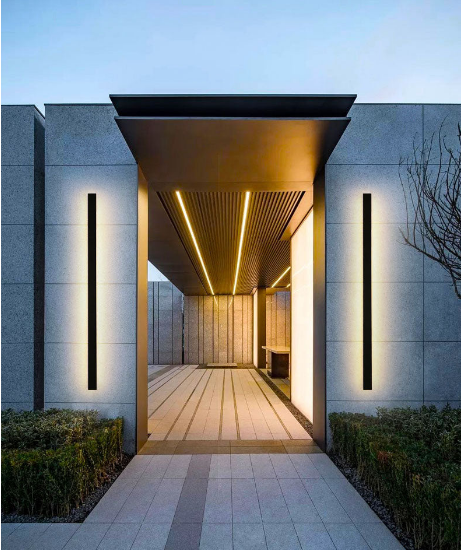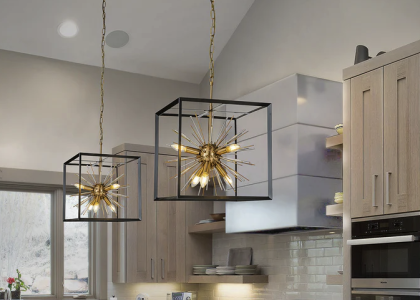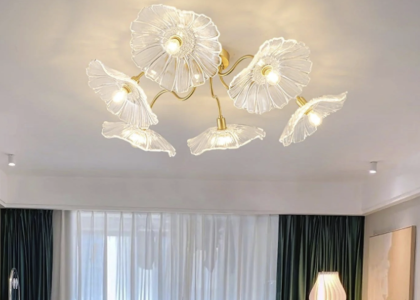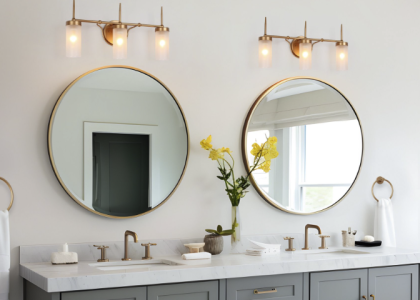Outdoor lighting refers to the use of lights to illuminate the exterior spaces of a property, such as gardens, patios, and pathways. It serves both functional and aesthetic purposes, enhancing the beauty of outdoor areas while also providing safety and security. Outdoor lighting can transform a dull and dark space into a vibrant and inviting one, allowing homeowners to make the most of their outdoor areas.
Benefits of Illuminating Your Garden
1. Enhances the beauty of your garden: Outdoor lighting can highlight the unique features of your garden, such as trees, plants, and architectural elements. By strategically placing lights, you can create a visually stunning landscape that can be enjoyed both during the day and at night. Lighting up your garden can add depth and dimension, making it a more inviting and enchanting space.
2. Increases safety and security: Well-lit outdoor areas can deter potential intruders and provide a sense of security for homeowners. By illuminating pathways, entrances, and dark corners, you can reduce the risk of accidents and make it easier for people to navigate your property at night. Additionally, outdoor lighting can help identify potential hazards such as steps or uneven surfaces.
3. Extends the use of your outdoor space: With proper lighting, you can extend the use of your outdoor space well into the evening. Whether you want to host outdoor gatherings or simply relax in your garden after sunset, having adequate lighting allows you to enjoy your outdoor areas at any time of day.
4. Adds value to your property: Outdoor lighting is not only aesthetically pleasing but also adds value to your property. Well-designed and properly installed lighting can enhance the curb appeal of your home, making it more attractive to potential buyers. It is a relatively inexpensive way to improve the overall look and feel of your property.
Types of Outdoor Lights to Choose From
1. Floodlights: Floodlights are powerful lights that provide a wide beam of light, making them ideal for illuminating large areas such as driveways or gardens. They are often used for security purposes, as their bright light can deter intruders.
2. Path lights: Path lights are low-level lights that are typically installed along pathways or walkways. They provide a soft and subtle glow, guiding people safely through the garden while also adding a decorative touch.
3. Spotlights: Spotlights are used to highlight specific features or focal points in the garden, such as statues, trees, or architectural elements. They create a dramatic effect by focusing a narrow beam of light on a particular area.
4. String lights: String lights are a popular choice for creating a festive and cozy atmosphere in outdoor spaces. They can be hung across trees, fences, or pergolas to add a warm and inviting glow.
5. Lanterns: Lanterns are versatile lighting options that can be placed on tables, hung from trees, or mounted on walls. They come in various styles and designs, adding a touch of charm and elegance to any outdoor space.
6. Solar lights: Solar lights are powered by sunlight and do not require any wiring or electricity. They are an eco-friendly and cost-effective option for illuminating your garden. Solar lights come in various forms, including path lights, spotlights, and string lights.
Factors to Consider Before Installing Outdoor Lights
1. Purpose of lighting: Before installing outdoor lights hozolighting , it is important to determine the purpose you want them to serve. Are you looking to enhance the aesthetics of your garden, improve safety and security, or both? This will help you choose the right type and placement of lights.
2. Location of lights: Consider the areas of your garden that you want to illuminate. Identify key features or focal points that you want to highlight and plan the placement of lights accordingly. Also, take into account the practicality of installing lights in certain areas, such as pathways or steps.
3. Power source: Decide whether you want to use wired or solar-powered lights. Wired lights require a power source and wiring, while solar lights rely on sunlight to charge their batteries. Consider the availability of power sources and the convenience of installation when making your decision.
4. Budget: Set a budget for your outdoor lighting project and stick to it. Consider the cost of lights, installation materials, and any additional features or accessories you may want to include. It is important to strike a balance between quality and affordability.
5. Maintenance: Outdoor lights require regular maintenance to ensure they continue to function properly and look their best. Consider the time and effort required for cleaning, replacing bulbs, and checking wiring before deciding on the type of lights to install.
DIY Outdoor Lighting Ideas
1. Mason jar lights: Transform ordinary mason jars into charming outdoor lights by inserting battery-operated LED string lights inside them. Hang them from trees or place them on tables for a rustic and whimsical touch.
2. Tin can lanterns: Create unique lanterns by punching holes in empty tin cans and placing tea light candles inside them. Hang them from hooks or tree branches to add a warm and cozy glow to your garden.
3. Wine bottle torches: Repurpose empty wine bottles by turning them into torches. Fill the bottles with lamp oil, insert a wick, and secure it with a cork. Place them along pathways or around seating areas for a stylish and functional lighting solution.
4. Rope lights: Use rope lights to outline pathways or create decorative shapes in your garden. They are flexible and easy to install, providing a soft and subtle glow that adds ambiance to your outdoor space.
5. Tree lights: Wrap string lights around the trunks or branches of trees to create a magical effect in your garden. This simple yet effective lighting technique can transform your garden into a fairytale-like setting.
Professional Outdoor Lighting Installation Services

1. Benefits of hiring a professional: While DIY projects can be fun and cost-effective, hiring a professional for outdoor lighting installation offers several advantages. Professionals have the knowledge and expertise to design and install lighting systems that are safe, efficient, and aesthetically pleasing. They can also provide guidance on the best type of lights to use and the most effective placement for optimal results.
2. What to look for in a professional installer: When choosing a professional installer, consider their experience, qualifications, and reputation. Look for someone who specializes in outdoor lighting and has a portfolio of previous projects to showcase their work. It is also important to check if they are licensed and insured to protect yourself and your property.
3. Cost of professional installation: The cost of professional outdoor lighting installation can vary depending on factors such as the size of the project, the type of lights used, and the complexity of the installation. It is recommended to get multiple quotes from different professionals to compare prices and services before making a decision.
Maintenance Tips for Outdoor Lights
1. Cleaning and replacing bulbs: Regularly clean your outdoor lights to remove dirt, dust, and debris that can affect their performance. Replace any burnt-out bulbs promptly to ensure consistent illumination.
2. Checking wiring and connections: Inspect the wiring and connections of your outdoor lights periodically to ensure they are secure and in good condition. Loose or damaged wiring can pose a safety hazard and should be addressed immediately.
3. Protecting lights from weather damage: Outdoor lights are exposed to the elements, so it is important to protect them from weather damage. Consider using weatherproof fixtures or covers to shield lights from rain, snow, or extreme temperatures.
Energy-Saving Outdoor Lighting Options
1. LED lights: LED lights are energy-efficient and long-lasting, making them an excellent choice for outdoor lighting. They consume less electricity than traditional incandescent bulbs and have a longer lifespan, reducing the need for frequent replacements.
2. Solar-powered lights: Solar lights harness the power of the sun to charge their batteries during the day, eliminating the need for electricity. They are a sustainable and cost-effective option for outdoor lighting, as they do not contribute to energy consumption or utility bills.
3. Motion sensor lights: Motion sensor lights are designed to turn on only when they detect movement. They are an energy-saving option for security lighting, as they only illuminate when needed and automatically turn off after a certain period of inactivity.
Creative Ways to Use Outdoor Lights in Your Garden
1. Highlighting garden features: Use spotlights or floodlights to highlight unique features in your garden, such as statues, water features, or architectural elements. This creates a focal point and adds visual interest to your outdoor space.
2. Creating a focal point: Install a statement light fixture, such as a chandelier or pendant light, in a central area of your garden to create a focal point. This adds a touch of elegance and sophistication to your outdoor space.
3. Setting the mood for outdoor gatherings: Use string lights or lanterns to create a warm and inviting atmosphere for outdoor gatherings. Hang them above seating areas or drape them across trees or pergolas to add a cozy and festive ambiance.
4. Illuminating pathways and steps: Install path lights along pathways and steps to ensure safe navigation at night. This not only enhances safety but also adds a decorative element to your garden.
Conclusion and Final Thoughts on Illuminating Your Garden
In conclusion, outdoor lighting is an essential element in creating a beautiful, safe, and functional outdoor space. It enhances the aesthetics of your garden, increases safety and security, extends the use of your outdoor areas, and adds value to your property. There are various types of outdoor lights to choose from, including floodlights, path lights, spotlights, string lights, lanterns, and solar lights. Before installing outdoor lights, consider factors such as the purpose of lighting, location of lights, power source, budget, and maintenance requirements. DIY options such as mason jar lights, tin can lanterns, wine bottle torches, rope lights, and tree lights offer creative and cost-effective solutions. However, for a professional and hassle-free installation, hiring a professional outdoor lighting installer is recommended. Regular maintenance is essential to ensure the longevity and performance of outdoor lights. Energy-saving options such as LED lights, solar-powered lights, and motion sensor lights are environmentally friendly and cost-effective. Creative ways to use outdoor lights in your garden include highlighting garden features, creating focal points, setting the mood for outdoor gatherings, and illuminating pathways and steps. Overall, illuminating your garden can transform it into a magical and inviting space that can be enjoyed day and night.





